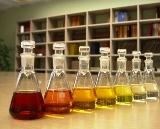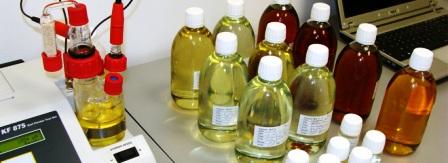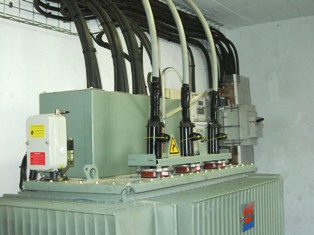Liquid dielectrics
 Liquid dielectrics can be classified according to different criteria.
Liquid dielectrics can be classified according to different criteria.
1. By chemical nature:
a) petroleum oils,
b) synthetic liquids (chlorinated and fluorinated hydrocarbons, silicon-silicon or fluorine-organic liquids, various aromatic-based derivatives, esters of various types, polyisobutylenes).
According to the specifics of the application for:
a) transformers,
b) switches and contactor devices for voltage regulation under load,
c) capacitors,
d) cables,
e) systems for circulation cooling and isolation of high-voltage installations.
3. At the upper limit of the permissible operating temperature:
a) up to 70 ° C (petroleum oils in condensers),
b) up to 95 ° C (petroleum oils in transformers, chlorinated hydrocarbons in capacitors),
c) up to 135 ° C (some synthetic and chlorinated hydrocarbons, some esters of silicic, phosphoric, organic acids, polyorganosiloxanes),
d) up to 200 ° C (some types of fluorocarbons, chlorine (fluorine) organosiloxanes),
e) up to 250 ° C (polyfilleters and special polyorganosiloxanes).
The classification according to the upper limit of the permissible temperature also depends on the performance characteristics of the dielectric fluid and the required service life.
4. According to the degree of flammability:
a) combustible,
b) non-combustible.
The specific requirements for a liquid dielectric are determined by the design and conditions of use of the equipment in which it is used, the degree of danger to the environment. The general requirements can be formulated as follows:
1) high dielectric strength,
2) high ρ,
3) low tgδ,
4) high stability under working, storage and processing conditions,
5) high resistance to electric and thermal fields,
6) high resistance against oxidation,
7) a certain value εd, taking into account the features of the electrical insulation structure,
8) compatibility with the materials used,
9) fire safety,
10) economy,
11) environmental safety,
12) low viscosity in the operating temperature range.

Modern technology for the production of power capacitors has led to a change in the requirements for the impregnating substance: it must be made on the basis of aromatic compounds and must have a low viscosity, good wettability of the polypropylene film, its negligible dissolution and swelling in the impregnating substance, a predetermined value of the mutual solubility of the impregnating substance and the polypropylene film, satisfactory stability at low temperatures, including low heating temperature, high gas resistance, non-toxicity, environmental safety and good biodegradability.
Liquid dielectrics, for example, in transformers perform an additional function as a cooling agent and provide removal of heat generated inside electrical equipment, which requires high heat capacity and low viscosity at the lowest operating temperatures.
Often, electrical faults are accompanied by arcs, arcs that can ignite the liquid, gaseous products of its evaporation or decomposition. It is important that the dielectric fluid, its vapors or gaseous decomposition products do not ignite in the event of electrical equipment failure; its resistance to ignition is evaluated by the degree of non-combustibility.
No dielectric fluid meets all of these requirements at the same time. We must focus on the most important requirements for a specific application case, compensating for individual shortcomings by limiting the operating conditions or making appropriate changes in the design of the electrical equipment.
For example, ensuring environmental safety led first to a reduction in the degree of chlorination and a corresponding increase in fire hazards, and then to an almost universal ban on the production and use of polychlorinated biphenyls (PCBs). Almost all existing substitutes are combustible. This shortcoming was compensated to a large extent by revising the design of the housing of the electrical equipment in the direction of reducing the probability of its dangerous damage in an emergency situation.
However, a large number of electrical equipment containing environmentally hazardous printed circuit boards is still in service.The operation of such electrical equipment requires strict compliance with special instructions. Measures are being taken to gradually replace printed circuit boards in transformers with environmentally friendly fluids. Debris containing printed circuit boards and malfunctioning equipment are destroyed.
The demand is high εd for capacitor liquid dielectrics can be compensated by increasing their resistance to the action of an electric field and correspondingly increasing the operating intensity of the electric field.

